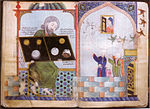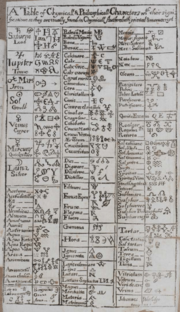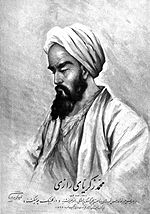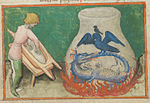Ibn Waḥshiyya (Arabic: ابن وحشية), died c. 930, was a Nabataean (Aramaic-speaking, rural Iraqi) agriculturalist, toxicologist, and alchemist born in Qussīn...
17 KB (1,896 words) - 12:37, 20 March 2024
kinds, such as to the ancient Egyptians and Greeks, or to Buddhists. Ibn Wahshiyya (died c. 930) used the term for a type of Mesopotamian paganism that...
44 KB (5,026 words) - 14:30, 29 May 2024
seeds. Ibn Wahshiyya wrote a detailed description of the practice. Layering was done with vines if there was enough space for it.: 107–8 Ibn Wahshiyya described...
61 KB (8,285 words) - 09:28, 9 May 2024
written The Nabatean Agriculture, is a 10th-century text on agronomy by Ibn Wahshiyya (born in Qussīn, present-day Iraq; died c. 930). It contains information...
46 KB (5,666 words) - 22:29, 20 May 2024
you may see question marks, boxes, or other symbols. Ibn Sina (Arabic: اِبْن سِینَا, romanized: Ibn Sīnā; c. 980 – 22 June 1037 CE), commonly known in the...
115 KB (13,297 words) - 20:22, 6 July 2024
is documented by the Muslim author Ibn Wahshiyya in his book Shawq al-Mustaham written in 856 A.D. Ibn Wahshiyya writes: "I saw thirty books in Baghdad...
45 KB (1,903 words) - 09:47, 1 June 2024
Abū Mūsā Jābir ibn Ḥayyān (Arabic: أَبو موسى جابِر بِن حَيّان, variously called al-Ṣūfī, al-Azdī, al-Kūfī, or al-Ṭūsī), died c. 806−816, is the purported...
79 KB (9,831 words) - 16:37, 12 July 2024
long-time rulers of the land. It is also from the pagan peasantry that Ibn Wahshiyya (died c. 930 CE) got most of his local information when compiling his...
11 KB (1,368 words) - 06:09, 10 July 2024
JSTOR 24975932. Hämeen-Anttila, Jaakko (2006). The Last Pagans of Iraq: Ibn Waḥshiyya and His Nabatean Agriculture. Leiden: Brill. ISBN 978-90-04-15010-2...
29 KB (3,177 words) - 05:18, 3 June 2024
works of Ibn Wahshiyya and Abu al-Qasim correctly identified the meaning of many of the signs. Other scholars have been sceptical of Ibn Wahshiyya's claims...
67 KB (8,862 words) - 22:58, 7 May 2024
transmit their beliefs. Marie-Louise von Franz describes in her introduction to Ibn Umail's "Book of the Explanation of the Symbols — Kitāb Ḥall ar-Rumūz" the...
26 KB (3,056 words) - 23:09, 7 July 2024
Emerald Tablet (section From the Kitāb Usṭuqus al-uss al-thānī (ca. 850–950) attributed to Jabir ibn Hayyan)
(Elementary Book of the Foundation) attributed to the 8th-century alchemist Jâbir ibn Hayyân, known in Europe by the latinized name Geber. Another version is found...
74 KB (7,944 words) - 18:36, 5 July 2024
Al-Zahrawi (redirect from Abu al-Qasim Khalaf ibn al-Abbas Al-Zahrawi)
Abū al-Qāsim Khalaf ibn al-'Abbās al-Zahrāwī al-Ansari (Arabic: أبو القاسم خلف بن العباس الزهراوي; 936–1013), popularly known as al-Zahrawi (الزهراوي)...
33 KB (4,132 words) - 09:03, 10 July 2024
the alembic was invented by Mary the Jewess. The anbik is described by Ibn al-Awwam in his Kitab al-Filaha (Book of Agriculture), where he explains...
6 KB (561 words) - 03:56, 27 December 2023
Abu Bakr Ibn Al-Qutia (died 997), historian and author born in Córdoba, Spain Abu Bakr Ahmed ibn 'Ali ibn Qays al-Wahshiyah, or Ibn Wahshiyya (9th/10th...
13 KB (1,679 words) - 03:14, 4 July 2024
Artephius pseudo-Avicenna Ibn Arfaʿ Raʾs Ibn Umayl (Senior Zadith) Ibn Waḥshiyya al-ʿIrāqī Jābir ibn Ḥayyān (Geber) pseudo-Khālid ibn Yazīd (Calid) al-Jildakī...
6 KB (620 words) - 05:26, 28 August 2023
venerate the stars". However, there is also a large corpus of texts by Ibn Wahshiyya (died c. 930), most famously his Nabataean Agriculture, which describes...
51 KB (5,493 words) - 10:47, 26 June 2024
edition claims to be a translation from Greek by 9th-century scholar Abu Yahya ibn al-Batriq (died 806 CE), and one of the main translators of Greek-language...
9 KB (1,058 words) - 07:45, 26 May 2024
Khālid ibn Yazīd (full name Abū Hāshim Khālid ibn Yazīd ibn Muʿāwiya ibn Abī Sufyān, Arabic: أبو هاشم خالد بن يزيد بن معاوية بن أبي سفيان), c. 668–704...
21 KB (2,417 words) - 12:16, 7 May 2024
Medicine in the medieval Islamic world (section Ibn Buṭlān – Yawānīs al-Mukhtār ibn al-Ḥasan ibn ʿAbdūn al-Baghdādī (Ibn Butlan))
being comprehensive. — al-Majusi, 10th century During the 10th century, Ibn Wahshiyya compiled writings by the Nabataeans, including also medical information...
117 KB (14,806 words) - 17:09, 22 June 2024
science (such as Hunayn ibn Ishaq, Yusuf Al-Khuri, Al Himsi, Qusta ibn Luqa, Masawaiyh, Patriarch Eutychius, and Jabril ibn Bukhtishu) and theology....
122 KB (13,772 words) - 00:33, 4 July 2024
Artephius pseudo-Avicenna Ibn Arfaʿ Raʾs Ibn Umayl (Senior Zadith) Ibn Waḥshiyya al-ʿIrāqī Jābir ibn Ḥayyān (Geber) pseudo-Khālid ibn Yazīd (Calid) al-Jildakī...
14 KB (1,059 words) - 15:15, 13 June 2024
in which portraits of Muhammad appear. Abu Hanifa Dinawari, ibn al-Faqih, Ibn Wahshiyya, and Abu Nu'aym al-Isfahani tell versions of a story in which...
78 KB (8,894 words) - 16:03, 6 July 2024
attempted to carry out the process. The eighth-century Muslim alchemist Jabir ibn Hayyan (Latinized as Geber) analysed each classical element in terms of the...
28 KB (3,274 words) - 13:39, 11 June 2024
and early 14th centuries. These writings were falsely attributed to Jabir ibn Hayyan (died c. 806–816, latinized as Geber), an early alchemist of the Islamic...
20 KB (2,481 words) - 05:26, 14 March 2023
Abu Bakr al-Razi (redirect from Abu Bakr Mohammad Ibn Zakariya Al-Razi)
Bakr al-Rāzī (full name: أبو بکر محمد بن زکریاء الرازي, Abū Bakr Muḥammad ibn Zakariyyāʾ al-Rāzī), c. 864 or 865–925 or 935 CE, often known as (al-)Razi...
75 KB (8,880 words) - 15:29, 1 July 2024
the one who discovered the river Kutha. In The Last Pagans of Iraq: Ibn Waḥshiyya and His Nabatean Agriculture, Jaakko Hämeen-Anttila says: "One might...
16 KB (2,264 words) - 22:00, 8 April 2024
Al-Kindi (redirect from Abu Yusuf Yaqub ibn Ishaq al-Sabbah Al-Kindi)
Abū Yūsuf Yaʻqūb ibn ʼIsḥāq aṣ-Ṣabbāḥ al-Kindī (/ælˈkɪndi/; Arabic: أبو يوسف يعقوب بن إسحاق الصبّاح الكندي; Latin: Alkindus; c. 801–873 AD) was an Arab...
48 KB (6,030 words) - 02:33, 7 June 2024
almost an entirely mystical discipline. It was at that time that Khalid Ibn Yazid sparked its migration from Alexandria to the Islamic world, facilitating...
112 KB (13,280 words) - 14:04, 9 June 2024
Artephius pseudo-Avicenna Ibn Arfaʿ Raʾs Ibn Umayl (Senior Zadith) Ibn Waḥshiyya al-ʿIrāqī Jābir ibn Ḥayyān (Geber) pseudo-Khālid ibn Yazīd (Calid) al-Jildakī...
8 KB (672 words) - 09:33, 23 June 2024






















